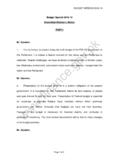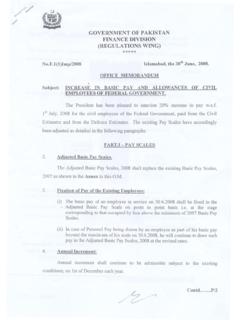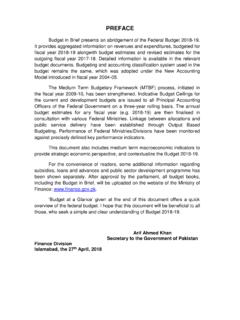Transcription of CHAPTER 14 Energy - Finance
1 CHAPTER 14 Energy Energy is vital to industry, transport, infrastructure, information technology, agriculture, household uses and more. Any nation that wants to grow its economy and improve living standards must secure a robust Energy supply. Energy use increases with the rise of incomes. As more countries rise out of poverty and develop their economies, Energy demand rises correspondingly. The Energy is costlier. Due to volatility in prices, supplies are becoming less secure, even for several fast-growing countries. Therefore, lowest-cost Energy become important. Earlier coal was considered as cheaper source of Energy but it is now become more climatic risky. Fast growing economies, therefore, trying to find low-cost gas as best alternative.
2 Responding to the challenge that domestic supplies cannot keep up with demand, a multifaceted approach will be required. One key task will be to increase resource efficiency and productivity. Innovation is also expanding. There is also rapid growth in renewable Energy resources, most notably wind and solar power. Still fossil fuels are the dominant sources of Energy powering the global economy. Oil is the most geopolitically important commodity as any structural change in oil markets can reverberate throughout the world. Rapid economic expansion had been witnessed in Middle East and North Africa (MENA) and Gulf Cooperation Council (GCC) over the past fifteen years.
3 It was the view that these economies had enjoyed growth on the back of booming oil prices. For last two years, the world is awash with oil which resulted in dramatic fall in prices. Thus recent plunging of oil prices have raised concern about the risk of slow growth, unemployment and inequality in these economies as well. The dropped in oil prices had adversely affected many countries, thus making economic activity in the world lackluster. There is less possibility of turning around of oil prices in 2016. Thus persistent weakness in aggregate demand in developed economies will remain a drag on global growth, while low commodity prices, mounting fiscal and current account imbalances and policy tightening will further dampen prospects for many commodity-exporting economies.
4 Attempting to understand how the oil market will look during the next few years has become a task of enormous complexity. There was claim that oil prices falling to twelve-year low will lead to a strong demand growth spurt but not observed as expected. Crude oil shipments totaled to US$ billion in 2015. A decline of percent in value is observed since 2011, and percent decline if to compare 2015 with 2014. Middle Eastern countries accounted the highest dollar value of crude oil exports during 2015 with shipments valued at $325 billion or percent of global crude oil exports. It can be seen that this amount can be compared with 18 percent of Europe, percent of North America and percent of Latin America (excluding Mexico) and Caribbean exporters1.
5 The other claim was that falling oil prices to twelve-year lows will force the largest group of producing countries to cut output to stabilize the oil prices but supply exceeded the demand by massive margins. In principle, oil importing countries should benefit from the decline in oil prices, but these are not yet been materialized on account of global uncertain economic environment. Many emerging economies are facing slow economic growth, However, Pakistan s growth over last three years is rising due to prudent government policies. Falling oil prices to some extent benefitted in the face of lowering import cost for industrial production. Further, the government has passed on the benefits of decreased oil prices to general public which also helped in containing inflation.
6 Correspondingly, Pakistan has responded to these 1 Pakistan Economic Survey 2015-16 238 developments by effective monetary policy and sound fiscal policies. Despite a plunge in crude prices, the Exploration and Production (E&P) companies operating in many parts of the world are reducing their costs by adopting different means. Pakistan thus got a chance to attract these companies to undertake new E&P activities as Petroleum Policy extends attractive incentives to oil and gas firms. Thus no international Oil/Gas E&P Company is considering of stopping operations as still Pakistan s current Petroleum Policy is offering best incentives.
7 During July-April FY 2016, foreign direct investment in oil and gas exploration remained US $ million compared to US $ million in corresponding period last year thus posting a growth of 2 percent. Government of Pakistan is also pursuing to enhance gas production in order to meet the increasing demand of Energy in the country. One of the milestone is import of LNG. In this regard a license for construction of LNG terminal was granted to M/s Engro Elengy Terminal Limited (EETL) with a construction validity period of two years. During July to Feb FY 2016, 175 mmcfd volume of Re-gasified liquid natural gas (RLNG) was imported. In the next couple of years Pakistan is expected to become a mature LNG import market with few more projects to come online along with natural gas pipeline capacity enhancement projects of the country.
8 The government has planned to establish 2nd LNG terminal which will be built at Port Qasim Karachi, to be operational by around mid-2017. Another company naming Bahria Foundation has also applied to OGRA for grant of LNG Terminal construction License. Due to increased content of Carbon Dioxide in atmosphere causing Global Warming Effect economies are shifting toward alternative Energy sources that have no undesired consequences. The government is taking all possible measures to ensure Energy security and sustainable development in the country. Efforts are underway to improve power sector fuel mix in the country to reduce price of power basket and improve financial viability.
9 Under the reforms, large capacity addition is planned from wind, solar, nuclear, hydel and coal power projects in the medium term. The emphasis is towards achieving a less oil dependent power generation mix through development of indigenous Energy resources particularly hydel, coal and renewable Energy resources for sustainable and affordable Energy supply in the country. Three hydel plants Tarbela-4th extension, Chashma, Neelum-Jehlum and few other small dams are expected to provide additional generation within next two years. Independent power producers (IPPs) and Generation Companies (GENCOs) are also being encouraged to convert from oil to coal based power generation, with the current coal tariff of cents per unit being a significant incentive in this regard.
10 In addition, 1000MW under Central Asia-South Asia-1000 (CASA-1000) power project is also included in the plan. Power sector has been given priority in terms of allocation of gas for power generation. All these efforts will improve the Energy mix whereby, reducing dependence on oil for power generation, and ensure reasonable tariffs for consumers, ultimately leading to financial sustainability. With concrete and sincere efforts of the government, almost 12 percent growth has been observed in real value addition of electricity generation & distribution and Gas distribution during FY 2015 and FY 2016 which in turn helped the real GDP growth of percent during FY 2016.










